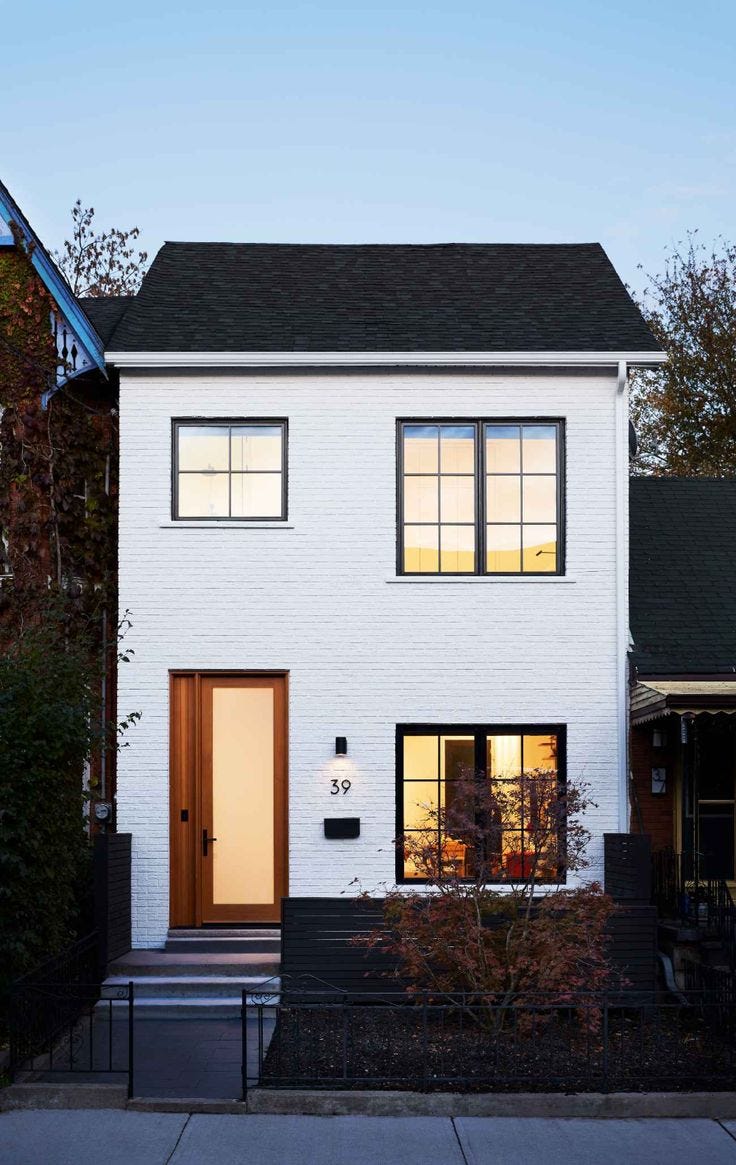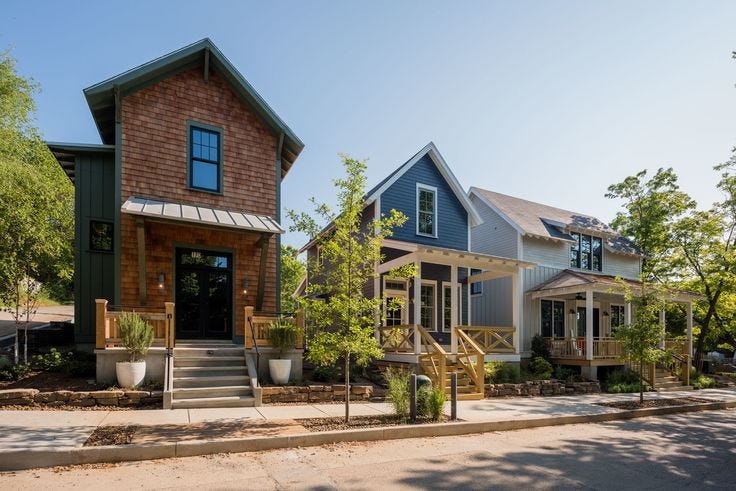How to Build (more) Affordable Housing - Part 3
Unlocking Affordable Housing Through Lot Subdivision: A Path to Homeownership
Most communities today are searching for innovative solutions to make homeownership more accessible. One promising approach that's gaining traction is allowing property owners to subdivide their existing lots into smaller parcels. This strategy offers a practical pathway to creating more attainable housing while leveraging the infrastructure and amenities that established neighborhoods already provide.
The Power of Smaller Lots, Bigger Dreams
Traditional suburban development often relies on large lots that drive up both land costs and total home prices. By enabling lot subdivision, communities can dramatically reduce the barrier to entry for prospective homeowners. When a single large lot is divided into two or three smaller parcels, the land cost per unit drops significantly, making it possible to build homes that fit within moderate-income budgets.
Consider a scenario where a homeowner has a half-acre lot in an established neighborhood. If local zoning allows subdivision into three quarter-acre lots, each new parcel immediately becomes more affordable for builders and buyers alike. The reduced land cost can translate to tens of thousands of dollars in savings per home, bringing homeownership within reach for teachers, nurses, young professionals, and other essential workers who've been priced out of many markets.
Infrastructure Already in Place
One of the most compelling advantages of lot subdivision is that the heavy lifting of infrastructure development has already been completed. Unlike greenfield developments that require new roads, water lines, sewer systems, and electrical grids, subdivided lots in existing neighborhoods can typically tap into established utilities with minimal additional investment.
This existing infrastructure represents enormous value. Water and sewer connections, electrical service, and paved roads are expensive to install from scratch, but subdivided lots can often access these services through relatively simple connections. This infrastructure advantage not only reduces development costs but also accelerates the building process, allowing new homes to come to market faster.
The Neighborhood Premium Without the Premium Price
Established neighborhoods offer amenities that new developments often lack: mature trees, walkable streets, proximity to schools and shopping, and the intangible benefits of community character. When lot subdivision occurs within these neighborhoods, new homeowners gain access to these established amenities without paying the premium typically associated with mature communities.
New residents moving into subdivided lots inherit the social infrastructure of the neighborhood—established relationships, community organizations, and local institutions. They're not waiting years for trees to grow or for neighborhood businesses to develop. Instead, they can immediately enjoy the benefits of a community that's already thriving.
An example of one large backyard becoming three small lots for new homes.
Financing Made Simple
Perhaps one of the most overlooked advantages of lot subdivision is how it simplifies financing for both builders and buyers. New single-family homes on subdivided lots can typically qualify for conventional mortgages, FHA loans, and other standard financing products. This stands in stark contrast to alternative housing models like condominiums or planned developments, which may face more complex financing requirements.
For builders, constructing traditional single-family homes on subdivided lots means working within familiar financing frameworks. Construction loans, permanent financing, and eventual buyer mortgages all follow well-established processes. This financing simplicity reduces risk and complexity, making projects more attractive to both small-scale and larger developers.
Buyers benefit from the full range of homeownership financing options, including first-time buyer programs, down payment assistance, and competitive interest rates. The homes can also appreciate in value like any other single-family residence, building equity for their owners over time.
Overcoming Common Concerns
Critics of lot subdivision often raise concerns about neighborhood character, parking, and density. However, thoughtful subdivision regulations can address these issues while still promoting housing affordability. Requirements for architectural compatibility, adequate parking, and appropriate setbacks can ensure that new homes complement rather than detract from existing neighborhoods.
Many communities have found success with "gentle density" approaches that allow subdivision while maintaining neighborhood scale and character. These might include design standards that ensure new homes fit the existing streetscape, requirements for landscaping and green space, and provisions for adequate parking. However, its very important to model any proposed design criteria on several real-world examples in the community. Too often, planning consultants believe they are solving problems by adding more regulations, but only end up creating new problems or making the solutions they were trying to enable impossible to deploy.
Real-World Success Stories
Portland, Oregon: Skinny Houses Deliver Affordability
Portland has become a national leader in small lot development through its "skinny house" program and zoning reforms. The city allows subdivision of existing lots as small as 2,500 square feet in certain zones, enabling construction of narrow homes on 25-foot-wide lots. In the early 1900s, large areas of Portland were platted as long, narrow lots measuring 25 to 33 feet wide and 100 feet deep, and the city later allowed these historic lots to be developed individually.
The results have been remarkable for affordability. New units typically sell for $300,000 LESS than traditional houses, making homeownership accessible to middle-income buyers who were previously priced out. Half dozen projects around the state show new townhomes are about 20% LESS expensive than new detached single family homes in the exact same neighborhood.
Portland's approach leverages existing infrastructure efficiently. These narrow-lot homes provided affordable housing options for many of the city's low- and median-income families as well as first-time homebuyers while utilizing water, sewer, and electrical systems that were already in place. The city's Living Smart Program, launched in 2004, helped ensure quality design standards while maintaining neighborhood compatibility.
Durham, North Carolina: Small Lot Revolution
Durham took an even more comprehensive approach with its 2019 "Expanding Housing Choices" (EHC) reforms. The city created a transformative Small Lot Code that allows for new homes to be built on lots up to 2,000 square feet, contingent on the home having a maximum of 1,200 square feet of livable space.
The impact has been swift and significant. The Small Lot provisions have been adopted faster than expected, with more than 50 units already built and more than 100 in the pipeline, and it appears that the majority of new detached homes being built in the urban tier of Durham are ones with Small Lot permits.
Durham's reforms also enable property owners to sell part of their property to help finance their mortgage and create smaller, more affordable lots. New construction rental projects that were not financially viable before suddenly became so by spreading expensive land costs across multiple houses, helping restart neighborhood-scale rental housing development.
Photo credit: Flintlock Lab
The program has created opportunities for individual homeowners to become small-scale developers. Homeowners who, when building their own house, can now build two additional homes, which can pay for some (and sometimes all) of their mortgage, demonstrating how subdivision can make homeownership more affordable for existing residents while creating new housing for others.
A Tool for Housing Diversity
These real-world examples show how lot subdivision creates opportunities for housing diversity within established neighborhoods. Smaller lots naturally accommodate smaller homes, creating options for empty nesters looking to downsize, young professionals seeking affordable starter homes, and small families who want to live in established communities.
This diversity can strengthen neighborhoods by ensuring they remain accessible to residents at different life stages and income levels. Rather than becoming exclusive enclaves, neighborhoods with subdivided lots can maintain economic diversity and continue to attract new residents who contribute to community vitality.
The Path Forward
For communities serious about addressing housing affordability, lot subdivision represents a practical tool that works within existing frameworks rather than requiring wholesale changes to development patterns. It leverages existing infrastructure, preserves neighborhood character, and creates genuinely affordable homeownership opportunities.
Success requires thoughtful policy design that balances affordability goals with community concerns. This might include streamlined approval processes for subdivision applications, clear design standards that protect neighborhood character, and provisions for adequate infrastructure capacity.
Local governments can support lot subdivision through zoning reforms that allow smaller minimum lot sizes, reduced setback requirements where appropriate, and streamlined permitting processes. They can also provide technical assistance to property owners interested in subdivision and work with builders to ensure projects meet community standards.
Building Communities, One Lot at a Time
Lot subdivision offers communities a path to address housing affordability while building on the strengths of established neighborhoods. By reducing land costs, leveraging existing infrastructure, and maintaining access to standard financing, this approach can create meaningful opportunities for homeownership without requiring massive public investment or wholesale changes to development patterns.
As communities across the country grapple with housing challenges, lot subdivision deserves serious consideration as part of a comprehensive approach to creating more attainable housing. It's not a silver bullet, but it's a practical tool that can help more families achieve the dream of homeownership while strengthening the neighborhoods they call home.








Looking forward to hearing you speak in Marquette later this year!
one thing i noted in Hefei in reference to housing was how they forced the developers to charge cost + 8% making housing very affordable. Thats how they managed to AVOID the Shenzhen property crises